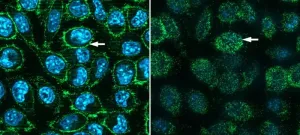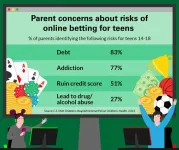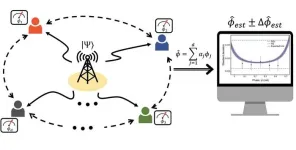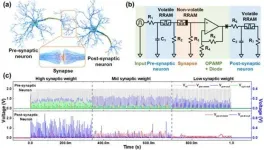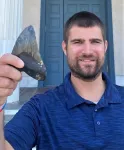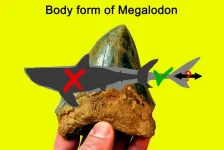(Press-News.org) (COLUMBUS, Ohio) – A new study conducted by researchers at the Center for Injury Research and Policy of the Abigail Wexner Research Institute at Nationwide Children’s Hospital and the Central Ohio Poison Center investigated trends in calls to poison centers across the country for exposures to liquid laundry detergent packets. The study investigators identified declines in the number, rate and severity of liquid laundry detergent packet exposures among children younger than 6 years. However, the exposure burden remained high. Additionally, exposures have increased among older children, teens and adults.
The study, published in Clinical Toxicology, found that in the most recent three years of the study, U.S. poison centers received 36,279 calls related to liquid laundry detergent packet exposures – an average of one call every 44 minutes. Most exposures involved children younger than 6 years (87%), a single substance (97%) or occurred at a residence (99%). Approximately 6% of single-substance exposures resulted in serious medical outcomes. During the study period, there were nine deaths associated with the ingestion of laundry detergent packets. All nine fatalities involved adults, seven of whom were older than 70 years.
According to previous research, in an effort to reduce unintentional exposures to the contents of liquid laundry detergent packets, ASTM published a voluntary Standard Safety Specification for Liquid Laundry Packets in 2015, but some experts feel it did not go far enough. Recent updates to the standard in March 2022 did not substantially change its scope. Multiple opportunities exist to strengthen the ASTM standard, including requiring Poison Prevention Packaging Act-compliant packaging or adopting additional “layers of protection,” such as individual packaging of each laundry packet.
“The voluntary standard, public awareness campaigns, and product and packaging changes to-date have improved the safety of these products, but a high number of children are still exposed each year,” said Christopher Gaw, MD, senior author of the study, emergency medicine physician and faculty of the Center for Injury Research and Policy at Nationwide Children’s. “There is still room for improvement.”
One reason for the less-than-expected decline in exposures among young children is likely because the voluntary safety standard permits manufacturers to meet the requirement for child resistant containers in six different ways rather than requiring them to conform to the Poison Prevention Packaging Act (PPPA) of 1970, which has been shown to be highly effective in preventing child access to poisons. “Requiring that all liquid laundry detergent packet packaging be PPPA-compliant would be an important next step in reducing child access to these products,” said Gary Smith, MD, DrPH, co-author of the study and director of the Center for Injury Research and Policy at Nationwide Children’s. “In addition, each laundry packet should be individually wrapped with child-resistant packaging, which would provide important layers of protection for this highly toxic product.”
Liquid laundry detergent packets are more toxic than traditional liquid and powder laundry detergents. The reasons for this increased toxicity are not completely understood, and further research is needed to determine how to make packet contents less toxic. Such reformulation would reduce the severity of exposures to liquid laundry detergent packets.
Pediatricians and other healthcare providers should continue to counsel patients and their families about the hazards of laundry detergent packet exposures and the importance of safe storage practices. Experts recommend that caregivers to children younger than 6 years old and adults with a history of dementia, Alzheimer’s disease or developmental disability use traditional laundry detergents instead of packets.
“Many families don’t realize how toxic these highly concentrated laundry detergent packets can be,” said Dr. Gaw. “If you have young children or vulnerable adults in your home, using traditional laundry detergents is a safer alternative.”
Data for this study were obtained from the National Poison Data System (NPDS), which is maintained by America’s Poison Centers, formerly the American Association of Poison Control Centers (AAPCC). Poison centers receive phone calls through the national Poison Help Line (1-800-222-1222) and document information about the product, route of exposure, individual exposed, exposure scenario, and other data, which are reported to the NPDS.
The Center for Injury Research and Policy (CIRP) of the Abigail Wexner Research Institute at Nationwide Children’s Hospital works globally to reduce injury-related pediatric death and disabilities. With innovative research at its core, CIRP works to continually improve the scientific understanding of the epidemiology, biomechanics, prevention, acute treatment, and rehabilitation of injuries. CIRP serves as a pioneer by translating cutting edge injury research into education, policy, and advances in clinical care. For related injury prevention materials or to learn more about CIRP, visit www.injurycenter.org. Follow CIRP on X @CIRPatNCH.
The Central Ohio Poison Center (COPC) provides state-of-the-art poison prevention, assessment and treatment to residents in 64 of Ohio’s 88 counties. The center’s services are available to the public, medical professionals, industry, and human service agencies. COPC handles more than 37,000 poison exposure calls annually, and confidential, free emergency poisoning treatment advice is available 24/7. To learn more about COPC, visit www.bepoisonsmart.org. Follow COPC on X @OHPoisonControl and Facebook https://www.facebook.com/CentralOhioPoisonCenter.
END
New study finds liquid laundry detergent packet exposure burden among young children remains; increase in exposures among older children, teens, and adults
Researchers call for renewed safety efforts to protect our most vulnerable populations
2024-01-22
ELSE PRESS RELEASES FROM THIS DATE:
Food from urban agriculture has carbon footprint 6 times larger than conventional produce, study shows
2024-01-22
Photos
A new University of Michigan-led international study finds that fruits and vegetables grown in urban farms and gardens have a carbon footprint that is, on average, six times greater than conventionally grown produce.
However, a few city-grown crops equaled or outperformed conventional agriculture under certain conditions. Tomatoes grown in the soil of open-air urban plots had a lower carbon intensity than tomatoes grown in conventional greenhouses, while the emissions difference between conventional and urban agriculture vanished for air-freighted crops like asparagus.
"The exceptions revealed by our ...
Scientists make COVID receptor protein in mouse cells
2024-01-22
UPTON, NY—A team of scientists at the U.S. Department of Energy’s (DOE) Brookhaven National Laboratory and Columbia University has demonstrated a way to produce large quantities of the receptor that SARS-CoV-2, the virus that causes COVID-19, binds to on the surface of human cells. That binding between the now-infamous viral spike protein and the human “ACE2” receptor is the first step of infection by the virus. Making functional human ACE2 protein in mouse cells gives scientists a new way to study these receptors and potentially put them to use. In addition, as described in a paper just published in the journal Virology, the ...
Researchers unveil new way to counter mobile phone ‘account takeover’ attacks
2024-01-22
Computer science researchers have developed a new way to identify security weaknesses that leave people vulnerable to account takeover attacks, where a hacker gains unauthorized access to online accounts.
Most mobiles are now home to a complex ecosystem of interconnected operating software and Apps, and as the connections between online services has increased, so have the possibilities for hackers to exploit the security weaknesses, often with disastrous consequences for their owner.
Dr Luca Arnaboldi, from the University of Birmingham’s School of Computer Science, explains: “The ruse of looking over someone’s shoulder to find out their PIN is well known. ...
What factors affect patients’ decisions regarding active surveillance for low-risk prostate cancer?
2024-01-22
Because low-risk prostate cancer is unlikely to spread or impact survival, experts and guidelines recommend active surveillance, which involves regular monitoring and thus avoid or delay treatment like surgery or radiation therapy and their life-changing complications. A new study examined the rates of active surveillance use and evaluated the factors associated with selecting this management strategy over surgery or radiation, with a focus on underserved Black patients who have been underrepresented in prior studies. The findings are published by Wiley online in CANCER, a peer-reviewed journal of the American Cancer Society.
For the study, called the Treatment ...
New sustainable method for creating organic semiconductors
2024-01-22
Researchers at Linköping University, Sweden, have developed a new, more environmentally friendly way to create conductive inks for use in organic electronics such as solar cells, artificial neurons, and soft sensors. The findings, published in the journal Nature Communications, pave the way for future sustainable technology.
Organic electronics are on the rise as a complement and, in some cases, a replacement to traditional silicon-based electronics. Thanks to simple manufacturing, high flexibility, and low weight combined with the electrical properties typically associated with traditional semiconductors, it can be useful for applications such as digital displays, energy storage, ...
Digital dice and youth: 1 in 6 parents say they probably wouldn’t know if teens were betting online
2024-01-22
As young people increasingly have access and exposure to online gambling, only one in four parents say they have talked to their teen about some aspect of virtual betting, a national poll suggests.
But over half of parents aren’t aware of their state’s legal age for online gambling and one in six admit they probably wouldn’t know if their child was betting online, according to the University of Michigan Health C.S. Mott Children’s Hospital National Poll on Children’s Health.
“Teens and young adults may have a difficult time going ...
Enable distributed quantum sensors for simultaneous measurements in distant places
2024-01-22
We've all had the experience of trying to get the exact time of a highly competitive concert ticket or class beforehand. If the time in Seoul and Busan is off by even a fraction of an hour, one will be less successful than the other. Sharing the exact time between distant locations is becoming increasingly important in all areas of our lives, including finance, telecommunications, security, and other fields that require improved accuracy and precision in sending and receiving data.
The Korea Institute of Science and Technology (KIST) announced that Dr. Hyang-Tag Lim and his team at the Center ...
Implement artificial neural network hardware systems by stacking them like "neuron-synapse-neuron" structural blocks
2024-01-22
With the emergence of new industries such as artificial intelligence, the Internet of Things, and machine learning, the world's leading companies are focusing on developing next-generation artificial intelligence semiconductors that can process vast amounts of data while consuming energy efficiently. Neuromorphic computing, inspired by the human brain, is one of them. As a result, devices that mimic biological neurons and synapses are being developed one after another based on emerging materials and structures, but research on integrating individual devices into a system to verify and optimize them ...
The megalodon was less mega than previously believed
2024-01-22
A new study shows the Megalodon, a gigantic shark that went extinct 3.6 million years ago, was more slender than earlier studies suggested. This finding changes scientists’ understanding of Megalodon behavior, ancient ocean life, and why the sharks went extinct.
The Megalodon or megatooth shark is typically portrayed as a super-sized monster in popular culture, with recent examples in the sci-fi films “The Meg” (2018) and “Meg 2: The Trench” (2023). Previous studies assume that the shark likely reached lengths of at least 50 feet and possibly as much as 65 feet.
However, the Megalodon is largely known only from its teeth and vertebrae in the ...
Slender shark: Study finds Megalodon was not like a gigantic great white shark
2024-01-22
CHICAGO — A new scientific study shows that the prehistoric gigantic shark, Megalodon or megatooth shark, which lived roughly 15-3.6 million years ago nearly worldwide, was a more slender shark than previous studies have suggested.
Formally called Otodus megalodon, it is typically portrayed as a super-sized, monstrous shark in novels and sci-fi films, including “The Meg.” Previous studies suggest the shark likely reached lengths of at least 50 to 65 feet (15 to 20 meters). However, ...
LAST 30 PRESS RELEASES:
Shingles vaccine linked to slower biological aging in older adults
A self-assembling shortcut to better organic solar cells
A two-week leap in breeding: Antarctic penguins’ striking climate adaptation
Climate risks to insurance and reinsurance of global supply chains
58% of patients affected by 2022 mpox outbreak report lasting physical symptoms
Golden Gate method enables rapid, fully-synthetic engineering of therapeutically relevant bacteriophages
Polar weather on Jupiter and Saturn hints at the planets’ interior details
Socio-environmental movements: key global guardians of biodiversity amid rising violence
Global warming and CO2 emissions 56 million years ago resulted in massive forest fires and soil erosion
Hidden order in quantum chaos: the pseudogap
Exploring why adapting to the environment is more difficult as people age
Society for Laboratory Automation and Screening welcomes new scientific director: Madeline M. Farley, Ph.D.
Austrian cow shows first case of flexible, multi-purpose tool use in cattle
Human nasal passages defend against the common cold and help determine how sick we get
Research alert: Spreading drug costs over the year may ease financial burden for Medicare cancer patients
Hospital partnership improves follow up scans, decreases long term risk after aortic repair
Layered hydrogen silicane for safe, lightweight, and energy-efficient hydrogen carrier
Observing positronium beam as a quantum matter wave for the first time
IEEE study investigates the effects of pointing error on quantum key distribution systems
Analyzing submerged fault structures to predict future earthquakes in Türkiye
Quantum ‘alchemy’ made feasible with excitons
‘Revoice’ device gives stroke patients their voice back
USF-led study: AI helps reveal global surge in floating algae
New method predicts asthma attacks up to five years in advance
Researchers publish first ever structural engineering manual for bamboo
National poll: Less than half of parents say swearing is never OK for kids
Decades of suffering: Long-term mental health outcomes of Kurdish chemical gas attacks
Interactional dynamics of self-assessment and advice in peer reflection on microteaching
When aging affects the young: Revealing the weight of caregiving on teenagers
Can Canada’s health systems handle increased demand during FIFA World Cup?
[Press-News.org] New study finds liquid laundry detergent packet exposure burden among young children remains; increase in exposures among older children, teens, and adultsResearchers call for renewed safety efforts to protect our most vulnerable populations
